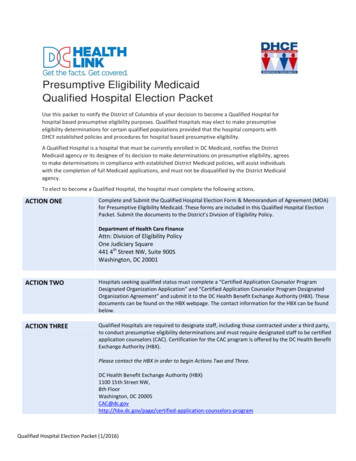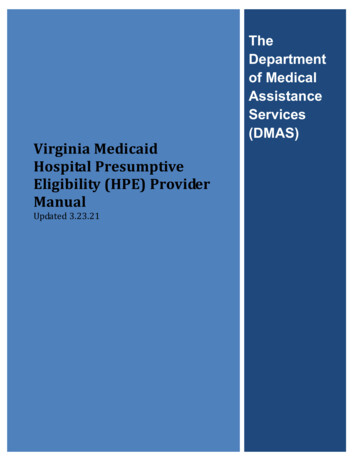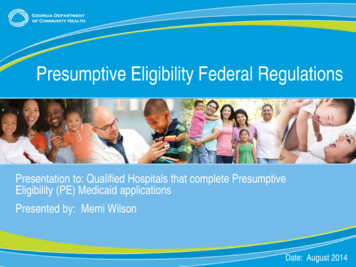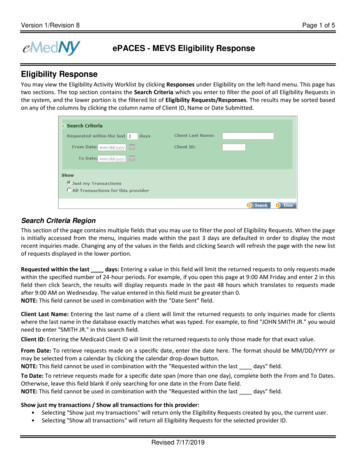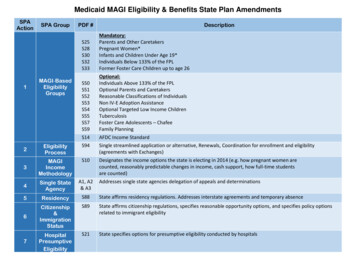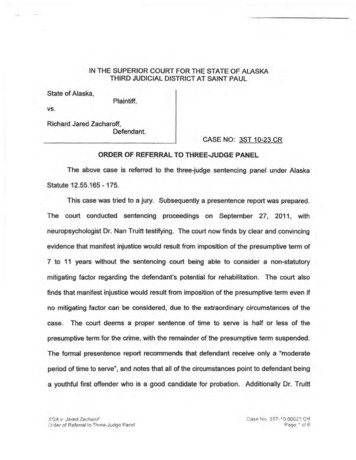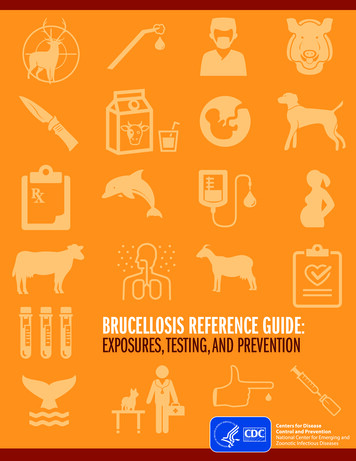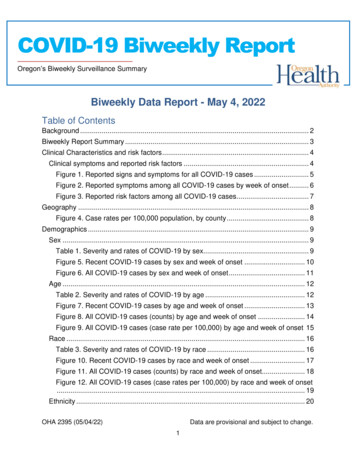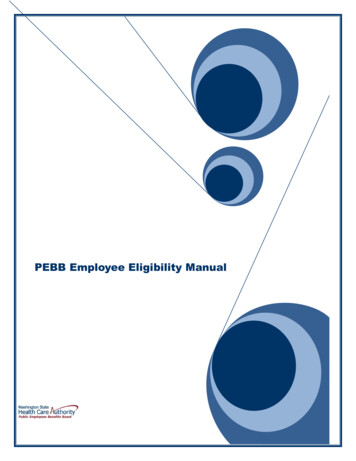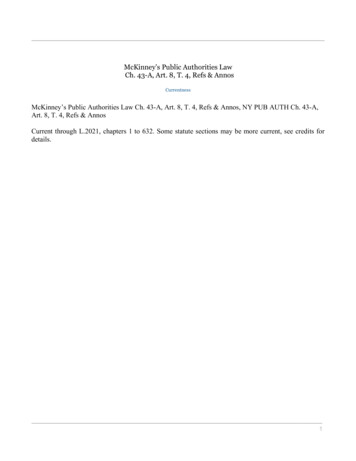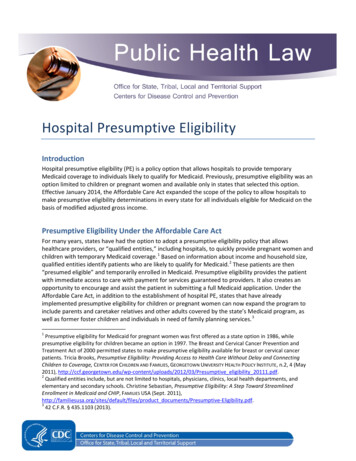
Transcription
Hospital Presumptive EligibilityIntroductionHospital presumptive eligibility (PE) is a policy option that allows hospitals to provide temporaryMedicaid coverage to individuals likely to qualify for Medicaid. Previously, presumptive eligibility was anoption limited to children or pregnant women and available only in states that selected this option.Effective January 2014, the Affordable Care Act expanded the scope of the policy to allow hospitals tomake presumptive eligibility determinations in every state for all individuals eligible for Medicaid on thebasis of modified adjusted gross income.Presumptive Eligibility Under the Affordable Care ActFor many years, states have had the option to adopt a presumptive eligibility policy that allowshealthcare providers, or “qualified entities,” including hospitals, to quickly provide pregnant women andchildren with temporary Medicaid coverage. 1 Based on information about income and household size,qualified entities identify patients who are likely to qualify for Medicaid. 2 These patients are then“presumed eligible” and temporarily enrolled in Medicaid. Presumptive eligibility provides the patientwith immediate access to care with payment for services guaranteed to providers. It also creates anopportunity to encourage and assist the patient in submitting a full Medicaid application. Under theAffordable Care Act, in addition to the establishment of hospital PE, states that have alreadyimplemented presumptive eligibility for children or pregnant women can now expand the program toinclude parents and caretaker relatives and other adults covered by the state’s Medicaid program, aswell as former foster children and individuals in need of family planning services. 31Presumptive eligibility for Medicaid for pregnant women was first offered as a state option in 1986, whilepresumptive eligibility for children became an option in 1997. The Breast and Cervical Cancer Prevention andTreatment Act of 2000 permitted states to make presumptive eligibility available for breast or cervical cancerpatients. Tricia Brooks, Presumptive Eligibility: Providing Access to Health Care Without Delay and ConnectingChildren to Coverage, CENTER FOR CHILDREN AND FAMILIES, GEORGETOWN UNIVERSITY HEALTH POLICY INSTITUTE, n.2, 4 (May2011), 03/Presumptive eligibility 20111.pdf.2Qualified entities include, but are not limited to hospitals, physicians, clinics, local health departments, andelementary and secondary schools. Christine Sebastian, Presumptive Eligibility: A Step Toward StreamlinedEnrollment in Medicaid and CHIP, FAMILIES USA (Sept. roduct documents/Presumptive-Eligibility.pdf.342 C.F.R. § 435.1103 (2013).
Hospital PE Program under the Affordable Care ActMore significantly, the Affordable Care Act requires all states to implement hospital PE, giving hospitalsthe opportunity to make presumptive eligibility determinations regardless of whether the state hadpreviously adopted the presumptive eligibility option. 4 Hospitals in every state can now use PEdeterminations to enroll individuals who are likely eligible under a state’s Medicaid eligibility guidelines,including children, pregnant women, parents and caretaker relatives, and former foster children. 5Hospitals may also make PE determinations for other groups that are covered by their state Medicaidprograms, including individuals with income above 133% of the federal poverty level and under age 65;individuals eligible for family planning services; and individuals needing treatment for breast and cervicalcancer. 6 At the discretion of each state, hospitals may also be allowed to make hospital PEdeterminations for other groups such as aged, blind, and disabled persons, as well as groups whoseeligibility is established by section 1115 waivers. 7 Hospital PE determinations are not limited to patientsbut can also be made for patients’ families and eligible individuals from the broader community. 8How Hospital PE WorksAt the initial visit of an individual who is not already enrolled in Medicaid, a hospital employee trained inconducting hospital PE determinations helps the individual complete a hospital PE application. 9 Thisassistance includes helping the individual answer required questions and calculate monthly familyincome and household size. 10If an individual meets the hospital PE criteria, the hospital must provide a written eligibility notice,information about beginning and end dates of the hospital PE period, and a summary of benefits. 11 Theemployee should also encourage the individual to apply for full Medicaid, including helping theindividual connect to an application counselor. 12 If presumptive eligibility is denied, the employee must442 C.F.R. § 435.1110(a) (2013).Id.6Id.7MEDICAID AND CHIP FAQS: IMPLEMENTING HOSPITAL PRESUMPTIVE ELIGIBILITY PROGRAMS 5 (Jan. 14.pdf. Section 1115 of the Social Security Act givesthe Secretary of Health and Human Services authority to approve experimental, pilot, or demonstration projectsthat promote the objectives of the Medicaid program. See Section 1115 Demonstrations, MEDICAID trations.html.8MEDICAID AND CHIP FAQS at 6.9HOSPITAL PRESUMPTIVE ELIGIBILITY: TRAINING TEMPLATE FOR QUALIFIED HOSPITALS 15, 0States have the option of using a simplified methodology to identify applicant’s household income. 42 C.F.R.§ 435.1102(a) (2013).11HOSPITAL PRESUMPTIVE ELIGIBILITY MODEL APPLICATION AND MEMORANDUM OF UNDERSTANDING, 24 (Feb. 20, E-WebinarDeck.PDF.12HOSPITAL PRESUMPTIVE ELIGIBILITY: TRAINING TEMPLATE FOR QUALIFIED HOSPITALS at 26.52
provide the reason for the denial and inform the individual of the option to submit a full Medicaidapplication. 13The PE period begins with and includes the day the hospital makes the determination. 14 If the individualsubmits a full Medicaid application by the last day of the month after the month that PE is determined,the PE period ends the day the state makes the eligibility determination for full Medicaid, whetherapproved or denied. If no full application is made, the PE period ends the last day of the monthfollowing the month in which the hospital makes the determination. 15 For example, if a hospital makes aPE determination on March 6, the PE period ends April 30, unless the patient submits a full Medicaidapplication before April 30.Benefits are the same as those provided under the Medicaid group for which the individual isdetermined presumptively eligible. 16 However, some exceptions apply. Pregnant women are limited toambulatory prenatal care benefits; birthing expenses are not covered. 17 The benefits for individualsseeking family planning care are limited to family planning services and supplies. 18State Implementation of the Hospital PE ProgramStates have flexibility in creating their hospital PE programs. For instance, a state can require citizenshipand residency attestations on hospital PE applications. 19 However, hospital PE determinations cannot beheld up for verification of these statuses. 20 States do not have to use a written application for hospitalPE but can simply ask the applicant for the information they need to make the determination and thenrecord the answers. 21 States can opt to allow hospitals to use the full Medicaid application to makehospital PE determinations, as long as the application makes it clear which questions do not have to beanswered for a hospital PE determination to proceed.22 The state can also choose to have a short-formhospital PE application and then require that the hospital help the applicant fill out the full Medicaidapplication. 23 Individuals cannot be required to submit a full Medicaid application as a condition ofreceiving hospital PE. 24 But states may require that the hospital helps the patient complete a fullapplication if the individual chooses to do so. 25 Hospitals must notify the state of approvals (and thedate range for the PE period) within five or fewer days using the process outlined by the state. 26 Federalregulations limit pregnant women to one hospital PE period per pregnancy; for non-pregnant13Id. at 33. Hospital PE denials cannot be appealed, but individuals can submit a full application.MEDICAID AND CHIP FAQS at 2.15Id. at 3.16Id. at 6.1742 C.F.R. § 435.1103(a) (2013).1842 C.F.R. § 435.1103(c)(1) (2013).19MEDICAID AND CHIP FAQS at 3.20However, verification of citizenship and immigration status is required before a final Medicaid eligibilitydetermination can be made. Id.21Id. at 3–4.22Id. at 3.23Id.24Id.2570 Fed. Reg. 42,177 (July 15, 2013) (to be codified at 42 C.F.R. pt. 435).26HOSPITAL PRESUMPTIVE ELIGIBILITY: TRAINING TEMPLATE FOR QUALIFIED HOSPITALS 33.143
individuals, states may limit the hospital PE period to a specified number of periods allowed in a giventime span. 27Although states are now required to implement hospital PE, hospital participation is optional, and statesmust provide a mechanism for a hospital to become qualified to conduct these determinations. 28 To bequalified to make hospital PE determinations, a hospital must participate in the Medicaid program,notify the state of its intention to make PE determinations by the process specified by the state, andagree to make PE determinations consistent with policies and procedures of the state. 29Once a hospital is a qualified entity, any hospital employee who is properly trained can make hospital PEdeterminations, including employees in hospital-owned physician practices or clinics, even if thoselocations are off site. 30 Participating hospitals may not delegate PE determinations to non-hospital staff,such as third-party vendors or contractors, although hospitals may implement PE with the support ofthird-party contractors. 31The state has the authority to take corrective action against hospitals, including disqualifying hospitalsfrom making PE determinations, if the hospital does not follow state policies or does not meetestablished standards. 32 However, the state cannot disqualify the hospital from conducting PEdeterminations until after it has provided the hospital with additional training or taken other reasonablecorrective action measures to address the issue. 33States are required to provide qualified hospitals with training in all applicable policies and proceduresrelated to hospital PE. 34 States had until March 31, 2014, to submit a Medicaid State Plan Amendmentthat outlined the state’s process for implementing the hospital PE program, including information onstate eligibility policies and procedures, training materials for hospitals, and the hospital PE application ifthe state intends to use a written application. 35 States have the option of requiring hospitals toadminister knowledge tests to employees making hospital PE determinations. 36All states must collect data on hospital performance to fulfill their oversight responsibilities, but eachstate can determine its own performance standards. 37 Potential performance metrics include a) theproportion of individuals determined presumptively eligible by the hospital who go on to submit a fullapplication or b) the proportion of individuals who are ultimately determined eligible for Medicaid onthe basis of the full application. 3827HOSPITAL PRESUMPTIVE ELIGIBILITY MODEL APPLICATION AND MEMORANDUM OF UNDERSTANDING 27.70 Fed. Reg. 42,176 (July 15, 2013) (to be codified at 42 C.F.R. pt. 435).2942 C.F.R. § 435.1110(b) (2013).30HOSPITAL PRESUMPTIVE ELIGIBILITY: TRAINING TEMPLATE FOR QUALIFIED HOSPITALS at 15.31MEDICAID AND CHIP FAQS at 6.3242 C.F.R. § 435.1110 (c)(2) (2013).3342 C.F.R. § 435.1110 (c)(3)(2013).3470 Fed. Reg. 42,289.35MEDICAID AND CHIP FAQS at 2.36Id. at 7.3770 Fed. Reg. 42,289.3842 C.F.R. § 435.1110(d)(1)(2013).284
Disclaimer: This summary was prepared by Lisa Caucci, J.D., M.A., Oak Ridge Institute for Science andEducation Fellow, with the Public Health Law Program (PHLP) within the Centers for Disease Control andPrevention’s Office for State, Tribal, Local and Territorial Support. PHLP provides technical assistance andpublic health law resources to advance the use of law as a public health tool. PHLP cannot provide legaladvice on any issue and cannot represent any individual or entity in any matter. PHLP recommendsseeking the advice of an attorney or other qualified professional with questions regarding the applicationof law to a specific circumstance. This issue brief includes research conducted through August 2014.5
4 Hospitals in every state can now use PE determinations to enroll individuals who are likely eligible under a state's Medicaid eligibility guidelines, including children, pregnant women, parents and caretaker relatives, and former foster children.5 Hospitals may also make PE determinations for other groups that are covered by their state Medicaid
